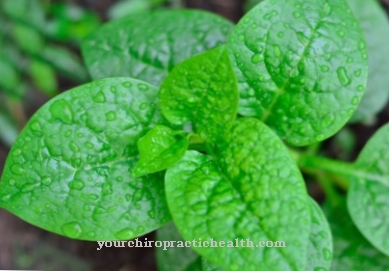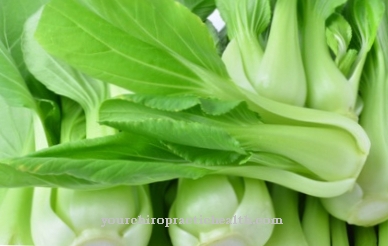The Root parsley is an old vegetable that is only available in winter. Visually, it represents a synthesis of carrot and parsnip. After having been used for a long time primarily as a soup green, the spicy-tasting root is now celebrating its comeback as an independent vegetable.
What you should know about root parsley

The root parsley, often too Parsley root called, is a subspecies of the popular leaf parsley, which is used worldwide in the form of herbs in the kitchen. The edible root is roughly the shape of a carrot, but is often more irregular in shape and overall thicker.
The shell as well as the edible part of the root is white to yellowish-brown. Similar to the carrot, the peel is provided with brown, ringy notches. From a botanical point of view, it belongs to the umbelliferae family. The plant is biennial and frost hardy.
The root parsley is a very old vegetable that was only used as a soup spice for a long time and is currently celebrating its comeback in German kitchens. It originally comes from the Mediterranean region, where it was already used as food by the ancient Romans. Nowadays it is particularly popular in Northern Europe, but is also cultivated worldwide. Its close relative, leaf parsley, in particular, also grows wild in many places.
As a winter vegetable, parsley root is usually only available fresh on the market from October to February. Thanks to its uncomplicated cultivation, it often comes from farmers in the region, even in the supermarket. In addition to being grown outdoors, some specimens also come from the greenhouse. Most specimens reach a length of around twelve to twenty centimeters. The root parsley has an intense but pleasant, spicy, slightly hot and at the same time subtly sweet taste, which is strongly reminiscent of the parsley, which is spread in the form of herbs, as well as reminiscent of the celeriac.
Essential oils give it this taste, which also make the parsley roots very digestible. The milder-tasting and somewhat thicker, but otherwise very similar-looking sister of the root parsley is the somewhat better-known parsnip.
Importance to health
The root parsley is an extremely healthy vegetable that is also very easy to digest. The very high vitamin C content of root parsley is particularly remarkable. One large root can cover up to four fifths of an adult's daily requirement of this vitamin. With its high vitamin C content, root parsley strengthens the immune system and the body's defenses when consumed regularly. It also contains vitamins of the B group, iron and calcium.
The essential oils contained not only support digestion, but also have a positive effect on the functioning of the kidneys, as they have a slightly diuretic effect in the body. For this reason, eating parsley root can help with mild kidney or bladder discomfort, as well as dropsy. However, the effect of root parsley is small and therefore only supportive and should only be seen as a supplement to other therapies.
The essential oils of root parsley can also help with flatulence. According to traditional medicine, parsley root is also said to be able to provide relief for menstrual cramps.
Ingredients & nutritional values
100 grams of raw parsley root, which is roughly equivalent to an average root, contain on average:
- 20kcal (84kJ)
- 2.8g protein
- 2.3g carbohydrates
- 0.6g fat
- around 88% water
- 41mg of vitamin C.
- 39mg calcium
- 0.85mg iron
- 12mg sodium
Intolerances & allergies
Allergies and other intolerances to root parsley are extremely rare. Only in very rare cases do allergic reactions of the skin or mucous membranes occur in direct contact with the root, but these are usually harmless. Particularly in very fair-skinned people, phototoxic reactions can occur, which are caused by the furanocoumarins contained.
Pregnant women should know that consuming very large amounts of root parsley can cause labor. In addition, due to its slightly diuretic effect, root parsley should not be consumed in the case of edema resulting from severe or even inflammatory kidney or heart problems.
Shopping & kitchen tips
The root parsley is usually only on the market in winter. The white roots are particularly available at the weekly market or in the organic market. Larger supermarkets with a well-stocked vegetable department have long since discovered the potential of root parsley for themselves and have it in their range as standard for the main season.
When buying, you should make sure that the roots look crisp and fresh, both visually and haptically. If the green is still at the root, it should also look fresh. At home, the roots should be placed in the vegetable compartment of the refrigerator or in the cellar, as they quickly lose freshness and become spongy at higher temperatures. They hold up particularly well if they are also wrapped in a damp cloth. In this way they can be stored for about a week without any loss of quality.
If the roots are washed off thoroughly before storage, they will last even longer. If the parsley roots do become wrinkled, they are still suitable as an ingredient in soup, provided they have no rotten spots. The root parsley is generally popular as a seasoning vegetable for soups, but it should also be tried once as an independent vegetable. Smaller roots mean extra work in the kitchen, but the aroma of smaller specimens is also particularly fine.
Preparation tips
A vegetable peeler is suitable for preparing the root parsley, just as with other root vegetables such as the carrot. Alternatively, if the bowl doesn't bother you, you can wash it off thoroughly. Then, just like carrots, the root parsley can be cooked as a vegetable garnish, made into a soup or puree or glazed.
Their aroma goes well with meat such as game and poultry, with potatoes or with chestnuts. An exciting aroma can be worked out from the roots with butter or with sweet aromas such as honey or with caramelization. Parsley roots also have numerous fans as a cream soup. Due to its extraordinary, spicy taste, it is well suited for festive dishes. The parsley root is particularly high season at Christmas.
In preparation, the root parsley is very grateful due to its short cooking time of no more than fifteen minutes. However, it is not only suitable for cooked dishes, but also finely donated for raw vegetable salads.
























.jpg)



